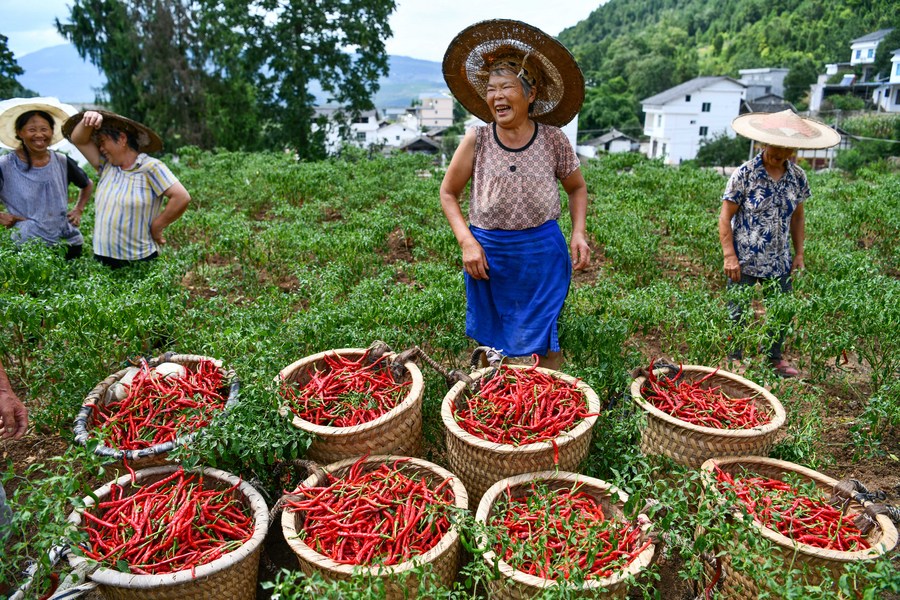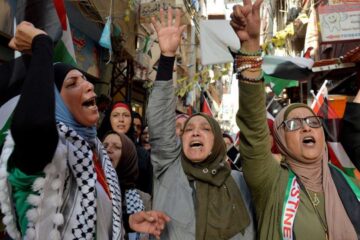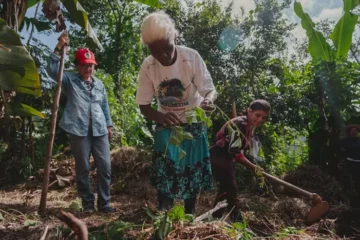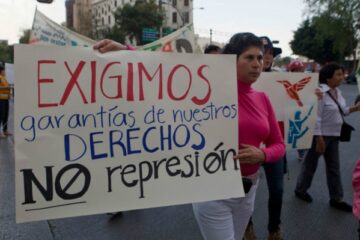The eliminating of extreme poverty is seen not as an end goal but as an important stage in the construction of socialism. Poverty, after all, is an issue of class struggle.
Grandmother He was born three years after the Chinese Revolution, into a poor village in the southwestern province of Guizhou. At the time, China was the world’s 11thpoorest country – that is, only eight African and two Asian countries were poorer than China in terms of per capita GDP. A “century of humiliation” at the hands of European and Japanese imperialism and a bloody civil war turned the world’s largest economy in the early 19thcentury to one of the poorest by the time the People’s Republic of China was founded in 1949. This history left devastating imprints on the life of the people, particularly peasant women.
When Grandmother He was born, she was expected to live about 35 years, likely to be wedded off as a child and stay illiterate her whole life. In her lifetime, however, she has seen her own lifespan double in length, women’s literacy grow from less than 10 percent to over 95 percent, and the dismantling of feudal patriarchal traditions. One of the first laws of the PRC was the 1950 Marriage Law, which prohibited practices of child and non-registered marriages, polygamy for men, and allowing divorces.
The Lancet’s commission on 70 years of women’s health in China writes, ‘Statements such as “Women hold up half the sky” and “Children are the future and hope of the motherland” have not only been rhetoric, but have been consistently practised.’ iAs one example, the study highlights the advances in maternal mortality, which dropped from over 1,500 to 17.8 cases per 100,000 births from 1949 to 2019. As a comparison, maternal mortality in Brazil dropped from 370 to 60 and in India from 1000 to 145 per 100,000 births over the same period. In other words, starting at much higher rates of maternal mortality, China managed to reach less than a third of Brazil’s and an eighth of India’s in seven decades. For the impressive achievements across women’s reproductive, maternal, newborn, child, and adolescent health the Lancetalso cites ‘strong political will’ and ‘improvements in gender equality’ as the key factors behind the successes. There are few places that this trend is clearer than in the fight against poverty.
On 25 February 2021, China announced that extreme poverty had been abolished for a country of 1.4 billion people, over that seven-decade period. Over the past forty years, China lifted 850 million people out of poverty. In other words, China lifted nearly the entire population of Latin America, the Caribbean, and another Brazil combined – contributing to 76% of the global reduction of poverty. This historic feat is made all the more impressive during the time of a great pandemic that has seen the first increase in global increase poverty since 1998, especially in the Global South. Grandmother He and her family were among the last 98.99 million people to exit extreme poverty in China, half of which were women.
In understanding the process of China’s poverty alleviation efforts, Tricontinental: Institute for Social Research launched a study, Serve the People: The Eradication of Extreme Poverty in China based on academic literature and media, interviews with key experts, and field research in the southwestern province of Guizhou. The study – available in English, Spanish, and Portuguese – found that, firstly, China relied on a multidimensional approach to poverty eradication, rather than cash-transfer or welfare-based schemes. Secondly, the campaign owed its strength to the Party-building efforts, particularly at the grassroots level in the countryside. Thirdly, the Chinese government demonstrated its capacity to mobilise the whole of society and its resources. Fourthly, the program centred the role of poor peasants in being lifted – and lifting themselves – out of poverty, and be protagonists in the process. Finally, the eliminating of extreme poverty is seen not as an end goal but as an important stage in the construction of socialism. Poverty, after all, is an issue of class struggle.

Don’t use a grenade to blast a flea
When Xi Jinping assumed presidency in 2013, “targeted poverty alleviation” (TPA) became the national program to reach the most difficult pockets of poverty, which did not reap the benefits of the preceding decades of economic development. ‘Don’t use a grenade to blast a flea’, Xi said, recognising that to address poverty, the government needed to accurately locate each poor family and develop a plan for their emergence from poverty. Over the course of this program, US$246 billion was spent to build 1.1 million kilometres of rural roads, bring internet access to 98 percent of the country’s poor villages, renovate homes for 25.68 million people, and build new homes for 9.6 million others.By the end of 2020, the remaining 98.99 million people from 832 counties and 128,000 villages exited extreme poverty.
The program was guided by the core policy of: One income, two assurances, and three guarantees. China’s poverty line is set at US$2.3 per day (PPP-adjusted), which is higher than the World Bank standard of US$1.9 per day. In addition to income, the TPA relies on the ‘two assurances’ of food and clothing, and the ‘three guarantees’ of basic medical services, safe housing with electricity and drinking water, and compulsory public education. In other words, China took on a multidimensional approach to poverty, guided by a minimum income, while providing the essential elements of food, education, housing, and healthcare to the rural poor.
Move amongst the people as a fish swims in the sea
Party mobilisation of its cadres was essential in the fight against poverty. In 2014, 800,000 Party cadres were organised to knock on the door of millions of households in 128,000 villages across the country. Their task was to identify each household to be registered into the national program, based on income, education, housing, and healthcare conditions. A national database of 100 million individuals was created to assist in planning and implanting programs for each of them.
The All-China Women’s Federation (ACWF) – the mass women’s organization led by the CPC – played a key role in incorporating the struggles faced by peasant women into the framework and practices of the TPA programme. For example, a 2010 survey found that women in key poverty-stricken counties had a poverty (9.8 percent) and illiteracy (15.7 percent) rates among women workers that were higher than men, and that they also had less access to technical training and social participation. The ACWF formed not only part of the country’s leading governmental bodies overseeing the TPA programme but also organised its base-building work both online and offline, from its 900,000 WeChat “sisters” groups (similar to Whatsapp groups) to 641,291 village-level grassroots organisations across the country.ii
Beyond identification, three million carefully selected cadres were sent to live in the countryside for years at a time, forming 255,000 teams that resided there – one team assigned to each village, one cadre for each family. Together with the villagers, a process of ‘democratic appraisal’ took place, in which community members debated and voted on the poverty situation of each family – who should be registered as poor, who had been lifted from poverty, and sometimes, who had fallen back into poverty. A high level of decentralisation, improvisation, and grassroots democracy in action took place. The conditions were tough, with 1,800 cadres losing their lives in the process.
United front against poverty
Beyond cultivating Party and public support, the poverty alleviation campaign mobilised broad sectors of society – a ‘united front’ against poverty – that included private, public, and civil sectors of society. The five core methods of addressing poverty included: developing industry; incentivising ecological compensation; guaranteeing free, quality, and compulsory education; relocation; and providing social assistance. The principal mechanism is developing industry, that is, developing productive capacity, specifically capital-intensive agricultural production. The second method was through ecological compensation, creating employment linked to the work of growing new forests, restoring farmlands, and reviving areas that have fallen prey to over-exploitation. Thirdly, improving education included building new facilities, training teachers, and providing huge incentives for students from peasant or poor families to go to university. As a result, from 2011 to 2018, 70 percent of first year students in Chinese universities were the first ever in their families to attend, and 70 percent of them were from peasant background. By 2020, China ranked first in the enrolment of women in tertiary education, according to the World Economic Forum’s Global Gender Gap Report.
For those who live in extremely remote or disaster-prone areas, it is nearly impossible to break the cycle of poverty without relocating. Less than 10 percent of the people who lifted themselves out of poverty did so through relocating to new areas. China built new homes – free, furnished, and in a community with schools and health clinics – for 9.6 million people in the program, as a last resort measure. Finally, especially for those who are unable to work – people with disabilities and the elderly – the final method of poverty alleviation is through social assistance.
The TPA programme was part of implementing the National Program for Women’s Development (2011-2020), which gave women priority access to funds and support, such as health care, micro-credit loans, and skills -training. A total of 10.21 million women registered in the TPA programme received skills training, with over five million working in crop and livestock production, handicrafts, tourism, and e-business. Micro-credit loans have helped 8.7 million women start businesses. The free breast and cervical cancer screenings were extended to all poor villages registered in the program in an effort to reduce illness-induced poverty, while about US$640 million was invested to provide 50 million poor mothers with infrastructure, health benefits, and daily necessities.
Protagonism of the poor
Grandmother He’s daughter, He Ying, used to be a work as a migrant labourer in another province, like many poor peasant women. During that decade, her son stayed in the village in the care of her Grandmother He who He Ying could only visit once a year. When she was pregnant with her second child, He Ying chose to enter into the government’s poverty alleviation programme and relocate to the new Wangjia community, despite initial opposition from her mother, father, and mother-in-law. The process of moving to a still-unknown place is a hard one for many elders who have never seen life beyond the village.
However as a poor person who participating in the process of being lifted – and lifting herself and her family out of poverty – He Ying became a member of the CPC. She now is one of the 12 cadres in the Wangjia relocation community, caring for the daily needs of 18,000 resettled residents. As the chairperson of the local ACWF chapter, He Ying helps build the confidence of newly migrated peasant women to overcome the many challenges they face. Through personal experience, she recognises the difficult transition that people have to make in relocating from the village to the city. In the early months of the relocation, He Ying’s husband grew uncomfortable witnessing his wife’s newfound independence as a leader.
‘I told [the local women] that women could hold up half the sky’, He Ying said. ‘If they could work, they would get more respect from their husbands and alleviate the [financial] burden on their families’. He Ying’s family of ten, which used to live in an 80-square-metre house together, now lives in three spacious apartments totalling 200 square metres. They live in a community with three community health centres and well-equipped and well-staffed kindergartens, one elementary school, and one middle school. What used to take her a two hour walk each way now takes five minutes to drop her younger son off at school.
He Ying’s elder son, who she had to leave behind to her mother’s care when she was a migrant worker, is now studying elevator maintenance at a technical school in the city. ‘There are sixty-four elevators in this community,’ she explains, ‘I hope that after graduation, he can come back and work in our community to serve the people too.’
Overcoming extreme poverty in China is an achievement of a size and scale that has never been seen in history. Rather than being the end point, it is one phase in the construction of socialism that must be deepened and expanded. To ensure prosperity in the countryside, the Chinese government has put forth a programme for rural revitalisation to consolidate and expand on the achievements in poverty alleviation.Many challenges lie ahead for peasant women, including combatting patriarchal values and promoting gender equality, increasing rural women’s participation in the labour force, bridging the “digital divide” and technical education for women, increasing childcare and elderly care.
The success of a national programme as big as the TPA should be measured not by abstract numbers alone but against the life of a poor peasant woman, like He Ying.The study aims to bring forth some of the experiences and stories, both from those who were lifted – and lifted themselves – out of poverty and from those who helped do the lifting. Building a world in which poverty is eradicated is an essential part of constructing socialism. To be able to study, have a house, be well fed, and enjoy culture are aspirations shared by the working classes and poor women across the world. It is part of the process of becoming human.
_
Tings Chak, researcher and coordinator of the Art Department of Tricontinental: Institute for Social Research, and a founding member of Dongsheng News. She was the lead author and researcher of Serve the People: The Eradication of Extreme Poverty in China and is based in Shanghai.




